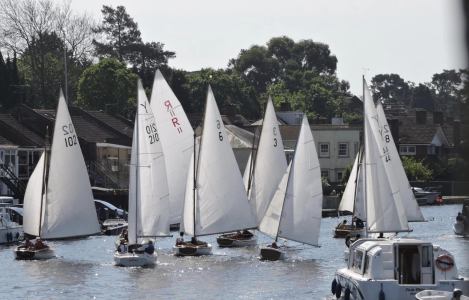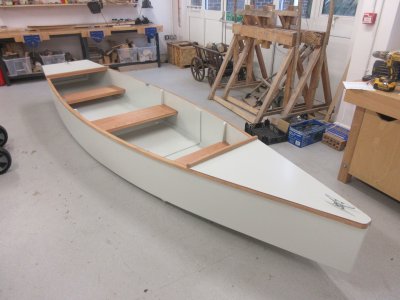Wansworth
Well-Known Member
Built a very light dinghy using two sheets of 8by4 4mm ply……no grp just good joints and well painted…….just one central mound and bow and stern using 9 mmply….pine gunwhales and other parts
Peter DuckYachting World Utility Pram, sailing version had rudder, daggerboard and standing lugsail, I learnt to sail on her but cannot find any rigged pictures, very stable. Built from a Bell Woodworking kit. Oh I love nostalgia.
Picture circa1960. Some may recognise the green yacht in the background, literary connection as a clue. She is still on the same river.
Chine runners acting as handholds on a inverted dinghyThanks for all the suggestions. I've built an epoxy and ply canoe already so I have an inkling of the timescales and costs involved...
I want to avoid a centerboard due to the space it takes up in the middle of the boat. Yes, a leeboard would be an option but seems to add complexity, either it will slide down a housing like a daggerboard in which case you need 2 housings, and are constrained to not having curvature in that part of the hull. Or else its on some sort of pivot in which case the mechanism will need to be very sturdy as all the load transfers through a single point.
Seems to me that if you had a pair of bilge runners running the length of the boat they may only need to be ~5cm tall to offer a similar sized lateral flat area to what you'd get from a centerboard?
If you're sailing, there's only one thing worse than a slow boat, and that's a slow boat which makes a lot of leeway.Thanks for all the suggestions. I've built an epoxy and ply canoe already so I have an inkling of the timescales and costs involved...
I want to avoid a centerboard due to the space it takes up in the middle of the boat. Yes, a leeboard would be an option but seems to add complexity, either it will slide down a housing like a daggerboard in which case you need 2 housings, and are constrained to not having curvature in that part of the hull. Or else its on some sort of pivot in which case the mechanism will need to be very sturdy as all the load transfers through a single point.
Seems to me that if you had a pair of bilge runners running the length of the boat they may only need to be ~5cm tall to offer a similar sized lateral flat area to what you'd get from a centerboard?
It really is not a severe restriction. You build it into the centre thwart and it helps stiffen the boat. It is not the area that determines its efficiency but its aspect ratio and position. Long shallow bilge keels are lousy at resisting leeway. The boats I built had simple ply dagger boards and fixed blade rudders and sailed tolerably well with a simple lug rig based on an Optimist sail. In fact I still have a complete rig including mast and sprit plus all hardware hanging up in my garage if you are interested.Thanks for all the suggestions. I've built an epoxy and ply canoe already so I have an inkling of the timescales and costs involved...
I want to avoid a centerboard due to the space it takes up in the middle of the boat. Yes, a leeboard would be an option but seems to add complexity, either it will slide down a housing like a daggerboard in which case you need 2 housings, and are constrained to not having curvature in that part of the hull. Or else its on some sort of pivot in which case the mechanism will need to be very sturdy as all the load transfers through a single point.
Seems to me that if you had a pair of bilge runners running the length of the boat they may only need to be ~5cm tall to offer a similar sized lateral flat area to what you'd get from a centerboard?

That looks lovely! Just the ticket for pottering around an anchorageI have just finished my second tender - picture below. I had the same concerns as you - weight as I get older , good to row ( considered a sail but decided no) or motor, strong and long lasting.
I decided against ply because ply is quite heavy. Instead I went for 6mm cedar strip- bought the plans for about £50 , the strip is bent around frames then the frames removed, and then the hull is glassed, leaving an extremely strong monocoque.
The dinghy lasted 18 years until a 50’ boat lost control and crushed it.
The design allows for a centre board and sail plan and the length is adjustable just by altering the frame spacing - 8ft to 12 ft is feasible.
Red cedar doesn’t rot easily ( hence used for garden sheds! ) and so you don’t have the same worry as you might with keeping water out of ply.
It’s not the cheapest construction and I don’t claim any great skill at building. If you want more details just pm me
Ist dinghy after 15 years use and new one.
Though if it were me I'd design my own
If you pick the right design it's a lot quicker than that... I built a Phil Bolger June Bug, which is 14' long and built to sail or row with a maximum load of 450kg, and it took me 25 hours, not including painting. The cost was three sheets of ply, some softwood and the paint; I used Semparoc (formerly Balcotan), a foaming polyurethane glue which is very forgiving and much cheaper and easier to work with than epoxy. I did use a bit of epoxy to seal the join and the plywood end-grain along the chine though.There are so many different tried and tested designs out there, I'd not have the confidence to invest hundreds of hours building my own design and wondering if it would turn out to be a lemon. But hats off to those who managed to do it.
How long do you expect the boat to last?If you pick the right design it's a lot quicker than that... I built a Phil Bolger June Bug, which is 14' long and built to sail or row with a maximum load of 450kg, and it took me 25 hours, not including painting. The cost was three sheets of ply, some softwood and the paint; I used Semparoc (formerly Balcotan), a foaming polyurethane glue which is very forgiving and much cheaper and easier to work with than epoxy. I did use a bit of epoxy to seal the join and the plywood end-grain along the chine though.
It's about six years old now, stored outside that whole time with no cover on. I think I might put a coat of paint on it this summer but otherwise it's doing fine. No tape on the joins. It's flat bottomed with vertical sides so the only real seam is at the chine, which has a softwood strip on the inside which the sides and bottom are glued and screwed onto. I then painted the external edges of the ply with epoxy and smeared thickened epoxy along the seam.How long do you expect the boat to last?
Any tape on the joins?
